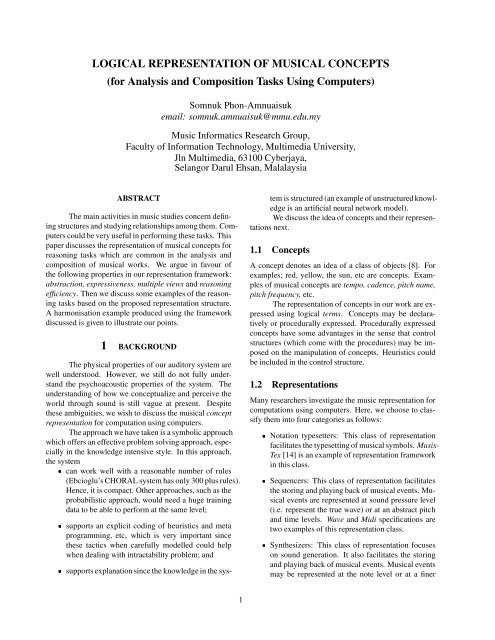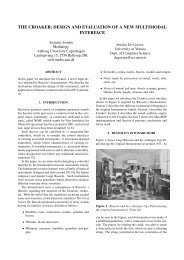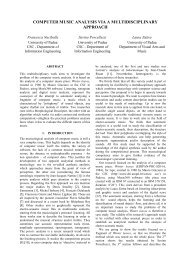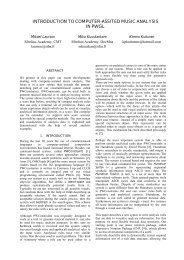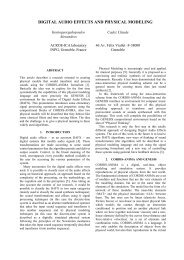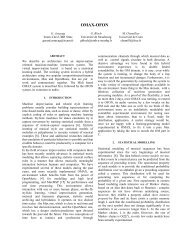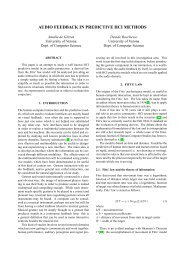LOGICAL REPRESENTATION OF MUSICAL CONCEPTS (for ...
LOGICAL REPRESENTATION OF MUSICAL CONCEPTS (for ...
LOGICAL REPRESENTATION OF MUSICAL CONCEPTS (for ...
You also want an ePaper? Increase the reach of your titles
YUMPU automatically turns print PDFs into web optimized ePapers that Google loves.
<strong>LOGICAL</strong> <strong>REPRESENTATION</strong> <strong>OF</strong> <strong>MUSICAL</strong> <strong>CONCEPTS</strong><br />
(<strong>for</strong> Analysis and Composition Tasks Using Computers)<br />
Somnuk Phon-Amnuaisuk<br />
email: somnuk.amnuaisuk@mmu.edu.my<br />
Music In<strong>for</strong>matics Research Group,<br />
Faculty of In<strong>for</strong>mation Technology, Multimedia University,<br />
Jln Multimedia, 63100 Cyberjaya,<br />
Selangor Darul Ehsan, Malalaysia<br />
ABSTRACT<br />
The main activities in music studies concern defining<br />
structures and studying relationships among them. Computers<br />
could be very useful in per<strong>for</strong>ming these tasks. This<br />
paper discusses the representation of musical concepts <strong>for</strong><br />
reasoning tasks which are common in the analysis and<br />
composition of musical works. We argue in favour of<br />
the following properties in our representation framework:<br />
abstraction, expressiveness, multiple views and reasoning<br />
efficiency. Then we discuss some examples of the reasoning<br />
tasks based on the proposed representation structure.<br />
A harmonisation example produced using the framework<br />
discussed is given to illustrate our points.<br />
1 BACKGROUND<br />
The physical properties of our auditory system are<br />
well understood. However, we still do not fully understand<br />
the psychoacoustic properties of the system. The<br />
understanding of how we conceptualize and perceive the<br />
world through sound is still vague at present. Despite<br />
these ambiguities, we wish to discuss the musical concept<br />
representation <strong>for</strong> computation using computers.<br />
The approach we have taken is a symbolic approach<br />
which offers an effective problem solving approach, especially<br />
in the knowledge intensive style. In this approach,<br />
the system<br />
can work well with a reasonable number of rules<br />
(Ebcioglu’s CHORAL system has only 300 plus rules).<br />
Hence, it is compact. Other approaches, such as the<br />
probabilistic approach, would need a huge training<br />
data to be able to per<strong>for</strong>m at the same level;<br />
supports an explicit coding of heuristics and meta<br />
programming, etc, which is very important since<br />
these tactics when carefully modelled could help<br />
when dealing with intractability problem; and<br />
supports explanation since the knowledge in the system<br />
is structured (an example of unstructured knowledge<br />
is an artificial neural network model).<br />
We discuss the idea of concepts and their representations<br />
next.<br />
1.1 Concepts<br />
A concept denotes an idea of a class of objects [8]. For<br />
examples; red, yellow, the sun, etc are concepts. Examples<br />
of musical concepts are tempo, cadence, pitch name,<br />
pitch frequency, etc.<br />
The representation of concepts in our work are expressed<br />
using logical terms. Concepts may be declaratively<br />
or procedurally expressed. Procedurally expressed<br />
concepts have some advantages in the sense that control<br />
structures (which come with the procedures) may be imposed<br />
on the manipulation of concepts. Heuristics could<br />
be included in the control structure.<br />
1.2 Representations<br />
Many researchers investigate the music representation <strong>for</strong><br />
computations using computers. Here, we choose to classify<br />
them into four categories as follows:<br />
Notation typesetters: This class of representation<br />
facilitates the typesetting of musical symbols. Musix-<br />
Tex [14] is an example of representation framework<br />
in this class.<br />
Sequencers: This class of representation facilitates<br />
the storing and playing back of musical events. Musical<br />
events are represented at sound pressure level<br />
(i.e. represent the true wave) or at an abstract pitch<br />
and time levels. Wave and Midi specifications are<br />
two examples of this representation class.<br />
Synthesizers: This class of representation focuses<br />
on sound generation. It also facilitates the storing<br />
and playing back of musical events. Musical events<br />
may be represented at the note level or at a finer<br />
1
©<br />
¨<br />
©<br />
¨<br />
<br />
<br />
<br />
<br />
©<br />
¨<br />
<br />
<br />
<br />
<br />
<br />
<br />
<br />
<br />
<br />
<br />
<br />
<br />
<br />
'<br />
<br />
<br />
<br />
<br />
-<br />
)<br />
<<br />
;<br />
<br />
, <br />
+<br />
*<br />
<br />
grain size (depending on the synthesis routine). The<br />
Music-N family and Csound are representative examples<br />
of this class. The Csound represents music<br />
at a signal processing level. This allows a direct access<br />
to a lower level than the note level.<br />
Inferrers: The term inferrers used here refers to a<br />
class of computation which places more emphasis<br />
on the symbolic inference process. In this class, the<br />
representation must support symbolic computation<br />
at the desired conceptual level (Interested readers<br />
may see [2, 3, 12, 15, 16]).<br />
There is no such thing as “a perfect representation<br />
framework”, since different frameworks have different<br />
advantages and disadvantages. For examples, the midi<br />
specifications adequately represent per<strong>for</strong>ming in<strong>for</strong>mation<br />
(e.g. velocity of a key, onset time and duration, etc).<br />
However, this midi framework cannot distinguish between<br />
¡£¢¥¤and¦¢¥§, as both share the same midi note number<br />
(i.e. number 61). This drawback comes from the expressiveness<br />
of the representation framework itself. To overcome<br />
drawbacks inherent in the chosen framework, the representation<br />
framework should be trans<strong>for</strong>mable to other<br />
frameworks [6]. We use the term multiple views to denote<br />
this idea.<br />
The abilities to see, hear and edit musical ideas<br />
are essential interfaces between human and music applications.<br />
Hence, notations typesetters, sequencers and synthesizers<br />
are common features and many commercial packages<br />
support these concepts. However, symbolic computations<br />
are not common in commercial packages. This<br />
is mainly due to the varieties and levels of the reasoning<br />
tasks required <strong>for</strong> different applications. For example, the<br />
transposition of a scale is a much simpler task than the<br />
filling of a cadence. Most commercial packages can per<strong>for</strong>m<br />
the transposition but not the more complex tasks of<br />
reasoning about cadence properties.<br />
Since complex tasks require expressive representation,<br />
the design of a representation framework is a very<br />
important issue. This leads us to the discussion of the<br />
representation of concepts used in symbolic computation<br />
tasks.<br />
2 AIMS<br />
The representation must support the reasoning we normally<br />
undertake (or believe we undertake). In other words,<br />
we would like to have the representation system that is native<br />
to our way of seeing and solving problems. Hence,<br />
there should be a minimal distortion in the mapping between<br />
the problem and the corresponding computational<br />
model, since this would allow us to express our problems<br />
and solutions at a level which is natural to our problem<br />
solving skills.<br />
We illustrate this by examining the tasks required<br />
in analysing a piece of work and highlighting the corresponding<br />
computational tasks in computers. This establishes<br />
how we should represent musical concepts in computers.<br />
We then highlight issues related to representation:<br />
abstraction, expressiveness, multiple-views and reasoning<br />
efficiency.<br />
2.1 Computational Musicology<br />
A piece of music can be analyzed from different perspectives.<br />
The activities involve narrating musical events; describing<br />
observed patterns; logical reasoning and numerical<br />
computing. The task of analysing usually aims to reveal<br />
syntactical structures and their associated meanings<br />
(which could be concept related to musical structures such<br />
as cadences, intervals; or concepts which are more subtle<br />
such as anger, happiness, sadness, etc).<br />
The excerpt below (only the first 9 bars) is a classic<br />
short piece from Schumann’s Kinderscenen, op. 15, titled<br />
Träumerei. We shall analyse the piece and then reflect<br />
on the analysis tasks we have per<strong>for</strong>med. The aim of the<br />
exercise is to highlight the nature of the analysis tasks.<br />
= 100<br />
<br />
<br />
"!! !! ##<br />
## $ ## % && <br />
&&<br />
(( <br />
<br />
<br />
2<br />
/ <br />
<br />
<br />
) 33 687 <br />
4 5 5 00 11 .<br />
ritard<br />
::<br />
&& <br />
9"::<br />
33<br />
cut...<br />
= / = ? @@BA > > > C D E= <br />
<br />
<br />
) <br />
>= && > <br />
Narrative and descriptive<br />
The leading figure of this narrative and descriptive style is,<br />
perhaps Donald Tovey (1875-1940). In this style, analysts<br />
describe the work; narrate the work; compare the work<br />
with and contrast the work against other works. However,<br />
analysts do not usually interpret the work with extramusical<br />
contents. The above music example would be described<br />
(in this style) as follow:<br />
The piece is from Schumann’s collection of<br />
short pieces from the album titled Kinderscenen.<br />
The piece is song number 7 of the to-
exact<br />
tal 13 songs. The piece is in the key of ’F<br />
major’. The first four-bar phrase progresses<br />
from tonic to subdominant, dominant and tonic<br />
be<strong>for</strong>e a closing in dominant. Schumann intentionally<br />
delays the accent (i.e. lengthen<br />
the notes, changes harmony) to the second<br />
beat of every bar. Prominent melody is in the<br />
top line all the time until the end of the phrase<br />
where the bass joins the first phrase and the<br />
second phrase together; and so on.<br />
Analyse Structural Patterns<br />
In this style of analysis, analysts only describe structures<br />
and patterns observed in the work. The observed structures/patterns<br />
may or may not be associated with other<br />
concepts (i.e. semiotics). This is similar to the descriptive<br />
style. However, this style tends to be more quantitative<br />
and, there<strong>for</strong>e, is very suitable <strong>for</strong> computers [1]. For<br />
example, the following musical patterns could be counted<br />
according to different criteria.<br />
Patterns<br />
exact<br />
FIG<br />
FHG<br />
match<br />
K <br />
FHG"LL J+<br />
Example of criteria<br />
match of interval<br />
match of interval/duration<br />
similar figure<br />
similar figure<br />
2.2 Abstraction, Expressiveness, Multiple views<br />
and Reasoning efficiency<br />
Abstraction and Expressiveness<br />
Abstraction and expressiveness are two important issues<br />
which we must consider in designing our representation<br />
framework. This is because we cannot include all the<br />
concepts we want in our universe of discourse due to intractability;<br />
so we have to be selective. We abstract the<br />
domain so that it is expressive enough <strong>for</strong> us to say things<br />
we want to say and abstract enough to be computationally<br />
feasible.<br />
Assuming we have decided to represent music at<br />
the abstraction level of pitch and time, there are many<br />
plausible predicates that represent music from these two<br />
dimensions (of pitch and time). For example, a pitch may<br />
be encoded in terms of Height, Chroma, Position in the<br />
circle of fifths or Name, Register or Key positions in a<br />
piano while time may be encoded in terms of physical<br />
time, duration, beat or rhythm. The main concern in this<br />
concept <strong>for</strong>mation task is that the chosen primitives and<br />
representation language must be expressive enough to allow<br />
discussions about the domain.<br />
It is our goal to represent music and to carry out<br />
musical analysis in somewhat conventional perspectives.<br />
We list examples of primitives below:<br />
Pitch-related attributes (e.g. Name, Accidental, Register,<br />
Frequency)<br />
Sonority-related attributes (e.g. Intervals, Chords)<br />
Per<strong>for</strong>ming instruction-related attributes (e.g. Forte,<br />
Piano, Accent)<br />
Analyse extra-musical Contents<br />
In this style of analysis, analysts are willing to give more<br />
interpretation of the music materials. This is common in<br />
the analysis of programmed music. The programmed contents<br />
are not totally groundless since many composers actually<br />
set their music with narrative scenes. An example<br />
of analysis in this style could be found in the analysis of<br />
Beethoven’s Pastoral symphony and the Ninth symphony<br />
(see [4, 9]).<br />
To capture and facilitate reasoning behaviours required<br />
in the above tasks, our representation must be expressive<br />
enough <strong>for</strong> the domain. As we have mentioned,<br />
there is no such thing as a perfect representation <strong>for</strong> all<br />
purposes. As such, the framework should support multiple<br />
views so that the representation could be in a structure<br />
most suitable <strong>for</strong> the computation task.<br />
match OO MG"NN<br />
Structure-related attributes (e.g. Key, Metrical structure,<br />
Phrases, Cadences)<br />
Process-related attributes (e.g. Order of tasks)<br />
General in<strong>for</strong>mation attributes (e.g. Genre, Piece name)<br />
Physical time (e.g. Clock time)<br />
Notated musical time (e.g. Pitch duration, tempo,<br />
beat)<br />
We construct knowledge of musical structure based on<br />
these primitive propositions (e.g. pitch name, pitch duration,<br />
pitch register, time, etc). For example: the predicate<br />
pitch(1,nat,4) may represent the pitch equivalent to<br />
the middle c on a piano.<br />
Multiple views<br />
We usually work with different representation shapes in<br />
any non-trivial problem solving process. Multiple views<br />
are different representation shapes of the same concept.
Multiple views are the mapping between different representation<br />
shapes and the base representation shapes<br />
S¥TVUXWZY\[^]`_aYbUS¥TcUXWedgfhTcikj).<br />
(PRQ<br />
Reasoning efficiency<br />
We sometimes find that it is more natural to code a piece<br />
of knowledge in procedural <strong>for</strong>m [13]. For example, a<br />
concept of musical cadences could be declaratively stated.<br />
We may declaratively describe different cadence types as<br />
follows:<br />
However, the same knowledge could be captured in a procedural<br />
style (as a function in this example).<br />
lamgnVõ`¥‘psrƒtu"wzyšwa|}mz€zI|crƒwzu"…X}oŽ€›†ˆ‡œysž{yŽœ–}mgnoŽ€<br />
lamgnVoqpsrbtvuxwzy{wa|~}mz€zv`¥‘t’‰`psu"y{wa|~}oŽ€“†”p{‰£…‰V‡¥|cu"•{‰s}mgn–o¥€ lamgnVo—|crƒw„u"…b}mz€“Ipsrbtvu"w„y{wa|~}oŽ€“†”u"t\‡a‰`ŠX‹‰`… |~}m“ncoŽ€ lamgnVoqpsrbtvuxwzy{wa|~}mz€z‚|crƒw„u"…b}o¥€g†ˆ‡a‰`ŠX‹‰£…Œ|~}mgnoŽ€<br />
harmony<br />
cadence<br />
sound<br />
harmony<br />
x,y<br />
a,b<br />
harmonyType(sound)<br />
cadenceType(harmony,harmony) ŸŸ are enough clues (either implicit or explicit knowledge<br />
in the system). The ability to move among different<br />
representation <strong>for</strong>ms is very useful as it could<br />
enhance reasoning efficiency since different tasks<br />
may require different representation shapes. Reasoning<br />
efficiency may be improved from the control<br />
structure [10].<br />
3 MAIN CONTRIBUTIONS<br />
3.1 Describing Concepts<br />
Representing musical concepts using logical language facilitates<br />
predication of concepts. The predicates chosen<br />
must be expressive enough to allow discussions of music<br />
theories at the appropriate level of the task (some examples<br />
of concepts are highlighted in Figure 1, such as tonic,<br />
dominant, anacrusis, melodic figures, etc. We do not label<br />
them in the figure <strong>for</strong> readability).<br />
function progression(x,y)<br />
a = harmonyType(x);<br />
b = harmonyType(y);<br />
return cadenceType( a,b )<br />
It there<strong>for</strong>e seems appropriate that we should allow procedural<br />
construction of primitive musical structures. Both<br />
declarative musical structures and procedural musical processes<br />
are hierarchical in nature. They may be constructed<br />
from many lower level structures and/or processes. Examples<br />
of procedural primitives are predicates such as subtract<br />
pitch, add pitch, etc; control structures in the lan-<br />
¡<br />
guage such as and, or, if–then, etc.<br />
We summarise that the representation of the domain<br />
knowledge must observe the following concepts:<br />
Abstraction and Expressiveness: The main purpose<br />
<strong>for</strong> this is to limit the size of the universe of discourse<br />
while still having enough vocabulary <strong>for</strong> the<br />
problem solving process. This is also dependent on<br />
the nature of the problem. For examples, <strong>for</strong>mal<br />
analysis would require that the system should be<br />
able to talk about the knowledge of musical structures<br />
(e.g. pitch, melody, harmony, texture, <strong>for</strong>m,<br />
cadence), however, frequency of the note may not<br />
be so important in this case and should be abstracted.<br />
Multiple views and Reasoning efficiency: If some<br />
in<strong>for</strong>mation is abstracted from the representation,<br />
we could always get the in<strong>for</strong>mation provided there<br />
Figure 1: Highlighted patterns are concepts<br />
Descriptions of musical knowledge in terms of: <strong>for</strong>m,<br />
melody, harmony, texture are common practices. This covers<br />
the concepts of pitches, modes, keys, triad chords,<br />
seventh chords, functional tonalities, modulations, simple<br />
ornamentations, melody, <strong>for</strong>ms of musical works, etc. We<br />
give some examples of concepts below:<br />
Describing <strong>for</strong>m, melody, harmony and texture<br />
The <strong>for</strong>mal structure of works in a particular genre abides<br />
to the common patterns. Examples of the concepts rele-
vant to <strong>for</strong>mal song structures are given below (based on<br />
the song Trüamarei).<br />
Time signature is¢¢,<br />
key signature is F major.<br />
The layout of the song is A–B–A’ with a repeat of<br />
the first two phrase (i.e. the A section).<br />
The contour of the melody, its rhythmic shape, the harmonic<br />
movement, the texture of the sound mass etc, are<br />
important features of a work. Examples of concept in this<br />
area are:<br />
all phrases start with anacrusis.<br />
the harmonic progression of the first phrase is: I–<br />
IV–I£–V¤–I–V.<br />
all phrases are held together by similarities in melody<br />
line and are contrasted by texture and harmonic colours.<br />
During the problem solving process, concepts related to<br />
the domain (i.e. <strong>for</strong>m, melody, harmony, texture) are generated,<br />
added to or deleted from the system.<br />
3.2 Describing concepts using logical language<br />
A logical language provides a natural framework <strong>for</strong> representing<br />
knowledge asserted in natural language. A brief<br />
description of some primitive categories in the language<br />
is given in Figure 2. Our knowledge representation is<br />
based on a logical approach. The knowledge of the world<br />
is represented as an atomic sentence which may be constructed<br />
with appropriate logical connectors. In brief, we<br />
may write our knowledge in a Horn<br />
¯¯¯¬°¨—±where¨is a literal and¥ is an atomic sentence.<br />
Examples of concepts described in a logical language are<br />
given below:<br />
clause:¥§¦©¨«ª£¬¨—®b¬<br />
Pitch: Pitch is an abstract representation of a set of<br />
tones. At this level the distinctions between pitches<br />
are in their orders which could be referred to as different<br />
frequencies or names. For example, we may<br />
represent a pitch as a tuple:<br />
_¡£¡`T¦UXikj³_¥¹Œ¸ŒºsUb»¥T³Ybj³UXº{¼;<br />
i.e. pitch[¾½1 2 3 4 5 6<br />
Integer [11].<br />
§x¿ÄÀ ½XiÂ_Žj䫧«§ 7¿ÁÀ ²d“Tcj³¡ƒ´„µ_Ž·°U¥¸<br />
Notated musical time: We quantify the representation<br />
of time used to quantify the length of pitches<br />
(e.g. duration) or other properties (e.g. beat). Time,<br />
<strong>for</strong> instance, may be represented using integers. The<br />
smallest unit of 1 could signify a demisemiquaver<br />
(thirty-second note).<br />
Note event: An event constructed from pitch, onset<br />
time and duration time could be predicated as<br />
event(pitch,onset,duration).<br />
Categories<br />
Description<br />
Constant<br />
34 An integer constant ‘34’ (which could mean<br />
anything apart from the quantity 34)<br />
0.6 A float constant ‘0.6’<br />
‘C major’ An atomic constant ‘C major’ corresponds<br />
to a term used in music theory.<br />
Variable<br />
Cadence<br />
A variable stands <strong>for</strong> some definite but<br />
unidentified object.<br />
Compound terms & Description<br />
scale(‘C major’,[c,d,e,f,g,a,b])<br />
The scale of C major has the pitch class of c d e f g a b c¡.<br />
perfectCadence(0.8)<br />
There are 0.8 probability that the cadence is a perfect cadence.<br />
chromaticInterval(min-third,3)<br />
A database entry indicates a number of semi-tones and their<br />
equivalent name (a minor third interval).<br />
chord(dominant,root(?Pitch))<br />
A variable pitch is a root of a dominant chord.<br />
gtpitch( +Pitch1,+Pitch2 )<br />
A function that returns ‘yes’ if Pitch1 is higher than Pitch2 and<br />
return ‘no’ if Pitch2 is higher than Pitch1.<br />
Figure 2: Example of Terms used in the system<br />
Definition 1 Concept protocol: A concept protocol is<br />
a collection of concepts. The construction of a protocol<br />
could be via prior knowledge or through a learning process.<br />
Definition 2 Concepts: A concept is a collection of attributevalue<br />
pairs. A concept is classified with the same name to<br />
the protocol it is most similar to. Attributes and values are<br />
terms (j΁).<br />
The value may either be declaratively or procedurally spe-<br />
S¥_¹–ɪ¸XÈx_¥jVj`¸ŒS_¹–É®¸¯¯Ê¯¸bÈ–_¥jVj`¸ŒS_¥¹É±g¿ ¡£fhi¡£Ud“jÇÆR½¥Èx_¥jVj`¸<br />
cified using primitive terms together with control structures<br />
(¡ƒÅ) available in its own language (Ë).<br />
Concepts may be constructed from other concepts as well<br />
(i.e. the values could be the collection of concepts under<br />
specified constraints).<br />
At implementation level, concepts are usually constructed<br />
in certain shapes (i.e. data structures) which are<br />
natural to the abstract machine being used.<br />
¡Å¿sÏ S_¥¹ÍÌνbjŸ<br />
3.3 The concept of the conventional Score<br />
In this section, we discuss how the real world musical notations<br />
are represented in computers. We use the term
ÒÑÑÑÑÑÑÑÑÑÑÑÑÑÑÐ<br />
ÐÑÑÑÒ |co£‡a‰ ‡u|…~Ó w„y{t‰Ôtu"psp{œÕ‰… `Ó¥y£‡a‰×ÖÙØbn³wzy{| nVÚbÛ Ü Ü y{|–|Ý •syšœÝ `Ó¥y£‡a‰<br />
ã psŠƒy{|u"rbw ä Ü Ü rbw“`‰~|áâu"t’‰<br />
•syŽœÝ ys||Ý<br />
àÞßßß<br />
àÞßßßßßßßßßßßßßß<br />
Ü<br />
Ü<br />
Score to denote the representation of knowledge of the real<br />
world score. The score concept contains a large amount of<br />
other musical concepts. Those concepts are represented in<br />
two main components: musical materials and interpretations.<br />
We notate the score using a constructor:<br />
Definition 5 Line: Line is a concept describing a sequence<br />
of note<br />
|co£‡a‰<br />
events.ÐÑÑÑÒ<br />
score(Musical materials, Interpretations)<br />
The musical material part represents knowledge in a shape<br />
suitable <strong>for</strong> describing the problem statement. The interpretations<br />
part represents knowledge in different viewpoints<br />
(depending on the tasks). The base music materials<br />
can be shaped and specialised to suit different computation<br />
models. New pieces of knowledge generated during<br />
the problem solving process may be added to or deleted<br />
from the interpretations. This leads us to a detailed discussion<br />
of music materials and interpretations.<br />
3.3.1 Music materials<br />
Music materials is a collection of concepts. Here we choose<br />
the concept of musical line as a surface representation.<br />
The decision to choose the representation shape as a surface<br />
representation depends heavily on the problem statement.<br />
For example, a line is a perfect surface representation<br />
if the problem statement describes a melody line. Let<br />
us discuss the examples of some important concepts, which<br />
we notate here as attribute-value matrices (AVM) [7]. The<br />
AVM used here has one feature which is unique from the<br />
notion of AVM used in most linguistic works. Here, the<br />
value of an attribute could be a program.<br />
Definition 3 Pitch: Pitch notations are based on the conventional<br />
western music notations. We could represent a<br />
pitch as a<br />
ºsUƒ»T³Ybj³Ubº{¼.<br />
tuple²d„Tcj³¡ƒ´“µÁ_¥·°UŽ¸_¡£¡`T¦UXikj³_¹³¸<br />
Definition 4 Note events: A note event e describes pitch<br />
and time in<strong>for</strong>mation. Other pieces of in<strong>for</strong>mation included<br />
at this level are those related to the notation (e.g.<br />
accent, staccato, trill, appogiatura, fermata, etc.) of each<br />
pitch event at the local level.<br />
|co£‡a‰ ‡¥u"|…~Ó wzyšt‰Ôtu"psp{œÕ‰… `Ó¥y£‡a‰×ÖÙØbn³wzy{| nVÚbÛ Ü Ü ÑÑÑÐÒ<br />
•syšœÝ y{|–|VÝ<br />
wzrƒ|c‰‰`•{‰`wa| wzy{t’‰ …Šƒrƒ|…~Ó‰~| |oƒ‡‰<br />
àÞ8ßßß<br />
Declaring shape using procedural knowledge<br />
àÞßßß<br />
wzyšt‰ ~rŒ‡Šby{wzr `Ó¥y£‡a‰×Ö‰hå~nV‰bæbnç8çÙçÙnŒ‰ÝÛ œu"w„‰<br />
Ü y{|–|VÝ •syŽœÊÝ Ü<br />
We have mentioned earlier that sometimes it is more natural<br />
to code knowledge in procedural <strong>for</strong>m. Examples<br />
of the interval concept below should illustrate the point.<br />
Here the shape is actually a logical program.<br />
Definition 6 Interval: Interval is a concept describing<br />
the distance between two pitches.<br />
3.3.2 Interpretations<br />
|co£‡a‰ wzyšt‰ ‡a‰`Šh‹‰`…Œ|‹¥u–‹Ž|VÓ `Ó¥y£‡a‰è`¥‘ŒéŒé¥}ꇥu"|…~Ó“å`nÕ‡u|c…~Óæ~€Â†ìë`‰£tvu|crƒw“‰ƒ ÑÑÑÐÒ àÞßßß uxwa|c‰£Šƒ•syšœ<br />
Interpretations is also a collection of concepts. Different<br />
concepts could be assigned to the same music materials to<br />
create multiple views. Actually, the concepts in the music<br />
materials and in the interpretations are of the same class.<br />
The concepts in music materials are the <strong>for</strong>m of concepts<br />
y{|–|Ý •syŽœÝ<br />
which we have decided to bring to the surface as the base<br />
representation. The concepts in interpretations are concepts<br />
which we usually add in, or delete from during the<br />
problem solving process.<br />
Interpretations are grouped under different general<br />
concepts such as <strong>for</strong>m, melody, harmony and texture. The<br />
groupings are arbitrary but must be consistent when adding<br />
new concepts to the interpretations.<br />
Interpretations =<br />
bírƒwz…~‰V‡¥|å~nírƒwz…~‰V‡¥|Væbn~çÙç8çÙnírƒwz…~‰V‡¥|Ý¡<br />
For example, a given melody line may have more than one<br />
views associated to it. Ebcioglu, in CHORAL, introduces<br />
the following views: the chord skeleton view, the fill-in<br />
view, the melodic-string view, the merged melodic-string<br />
view and the time-slice view [5].<br />
3.4 Reasoning with musical concepts<br />
Symbolic reasoning involves the manipulation of symbols.<br />
We need to be able to manipulate knowledge contents in<br />
our score representation. The basic operations are the<br />
abilities to create new concepts, retrieve, delete and edit<br />
existing concepts.
:<br />
:<br />
ÒÑÑÑÑÑÑÑÑÑÑÑÑÑÑÐ<br />
:<br />
wzy{t’‰ |oƒ‡‰<br />
… Šbr£|c…Ó‰~| w„r£|V‰‰`•{‰`wz|<br />
äã<br />
àÞßßßßßßßßßßßßßß<br />
Forming new concepts<br />
New concepts could be created from a set of existing concepts.<br />
For example a set of pitches being grouped under<br />
specific constraints could be viewed as a chord; or a<br />
melody line; or a motive, etc. There are some issues we<br />
need to consider when we create new concepts from a collection<br />
of existing concepts.<br />
Well-<strong>for</strong>med structure: We impose prior knowledge<br />
by specifying the well-<strong>for</strong>med structures of interesting<br />
musical structures. This abstraction limits unfruitful<br />
combinations of concepts. The grouping of<br />
two or more concepts depends on the nature of the<br />
new concept being created. The grouping must con<strong>for</strong>m<br />
to the grouping grammar (e.g. a note event is<br />
<strong>for</strong>med from pitch and time, a line is a collection of<br />
note events, etc).<br />
Compatibility: Two groupable concept may share<br />
some attributes. The shared attributes must be compatible,<br />
e.g. the attribute-value pair (key,’F major’)<br />
is not compatible with the pair (key,’G major’), but<br />
is compatible with (key,Key) or (key,’F major’).<br />
õ |co£‡a‰ ‡u|c…Ó wzy{t’‰ötvuxpsp{œ‰… `Ó¥y£‡a‰÷ÖêØXn³wzys|ncÚbÛZø rbw“`‰~|áâu"t’‰ £ÓŽyƒ‡‰<br />
‹¥wz… |uxrƒw psrƒtu"wzyšwa| ùŽ‰`oŽú›u"ž{wzys|c¥ŠX‰ ûÊüÃtybýXrbŠƒû psŠƒys|cu"rbw<br />
‡u"yšwzr •srbœt’‰ Ø`þbã u"w“|cŠƒt’‰`wa|<br />
note event<br />
type Crotchet type<br />
name<br />
shape<br />
shape<br />
onset 0<br />
name<br />
duration 8<br />
key signature ’F major’<br />
instrument piano<br />
pitch<br />
[1,nat,4]<br />
middle c<br />
Comparing concepts<br />
A concept may be noted as a directed graph. Attributes are<br />
edges and values are leaf nodes of the graph. The figure<br />
below shows an attribute-value matrix and the equivalent<br />
directed graph. The common <strong>for</strong>m of concept comparison<br />
is unification. Measuring similarity is another important<br />
comparison technique. One way to justify the similarity<br />
between concepts is to compare the size of the isomorphic<br />
sub-graph that they share. However, each attribute-value<br />
pair does not carry the same significant weight. So in practice,<br />
each concept protocol should have its own comparison<br />
procedure.<br />
Trans<strong>for</strong>ming concepts<br />
There are some basic building blocks which are well developed<br />
in music theory (e.g. pitches, intervals, scales,<br />
chords). Hence, it is possible to manipulate them using<br />
generic operations. Examples of these operations are:<br />
The basic operation of time: Time dimension is the<br />
landmark of note events. Basic arithmetic on the<br />
time is an essential requirement. For examples,<br />
and subîXïrefer to add and subtract operations, where<br />
ðandñare each of½p i t d¿standing <strong>for</strong> pitch, interval,<br />
time and duration respectively [16].<br />
addîXï<br />
Duration<br />
addôò : TimeóDuration†<br />
Time<br />
TimeóTime†<br />
Duration<br />
DurationóDuration†<br />
Duration<br />
DurationóDuration†<br />
volume 120<br />
Figure 3: An AVM and a directed graph of a concept<br />
The basic operation of pitches: Pitch comparison is<br />
the basic operation of a pitch class. To compare the<br />
height between pitches (e.g. C4 is higher than C3).<br />
Basic comparisons are greater than; less than; equal<br />
to; greater than or equal to; less than or equal to<br />
[16].<br />
:<br />
: subéŒé<br />
eqé<br />
:<br />
:<br />
é<br />
:<br />
:<br />
gtéŒé subé~ÿ subéŒé addé~ÿ subé~ÿ<br />
Boolean<br />
Boolean<br />
PitchóPitch†<br />
Interval<br />
Pitch<br />
Pitch<br />
PitchóPitch†<br />
Interval<br />
Pitch<br />
PitchóInterval†<br />
Operations by means of rules, tests and measures<br />
The generic operations tend to be reusable when the knowledge<br />
content is viewed from the same perspective. The<br />
combination of these operations is limitless. However the<br />
behaviour of a single operation or their compositions may<br />
be classified into three main categories:<br />
Operations which yield boolean true or false. These<br />
operations are classified as tests.<br />
Operations which yield measurements. These operations<br />
are classified as measures.<br />
addò ò<br />
:<br />
subò ò subôÕô
©<br />
¨<br />
©<br />
¨<br />
©<br />
¨<br />
AA<br />
AA<br />
AA<br />
AA<br />
©<br />
¨<br />
<br />
<br />
<br />
<br />
<br />
<br />
¥ <br />
¦¦<br />
A<br />
<br />
¥<br />
A<br />
¤ <br />
<br />
£<br />
<br />
<br />
<br />
A<br />
<br />
><br />
<br />
¤ <br />
<br />
<br />
<br />
¦¦A<br />
£<br />
> 00<br />
<br />
<br />
¢¢<br />
¥ <br />
§§> ¢¢A<br />
<br />
<br />
<br />
A¦¦ <br />
<br />
¤<br />
A<br />
£<br />
<br />
<br />
<br />
<br />
00A<br />
<br />
Operations which yield a concept output. These operations<br />
are classified as rules.<br />
Assuming that we are looking <strong>for</strong> a plausible next pitch<br />
from a given a pitch, we could construct an operation which<br />
gives a set of plausible progressions from the given pitch<br />
(rules). Then the answer may be quantified according to<br />
some specifications (measures); or filtered according to<br />
some criteria (tests).<br />
4 EXAMPLES<br />
The idea presented in this paper has been implemented<br />
in a system that harmonises a given melody input<br />
(see [10] <strong>for</strong> more in<strong>for</strong>mation). The example below illustrates<br />
the harmonisation of Bach’s chorales titled O Haupt<br />
voll Blut und Wunden.<br />
The system takes the original Bach’s melody and<br />
fills in other voices automatically. Of course, to be able to<br />
do this, the system must be equipped with the necessary<br />
domain knowledge.<br />
¤<br />
SA<br />
TB<br />
AA¡ 00 00<br />
AA<br />
¢¢ ¢¢<br />
<br />
£ <br />
¢¢A<br />
Representing musical concepts in the proposed framework<br />
yields expressive representations and supports symbolic<br />
computation using computers. The proposed framework<br />
is related to the CHARM’s hierarchical structures of<br />
events, constituents [16, 11]. The proposed framework extends<br />
the idea presented in CHARM by expressing musical<br />
concepts using a language framework (where the value<br />
of an attribute could be declaratively or procedurally expressed).<br />
Representing a concept protocol as a list of attributevalue<br />
pairs is simple, yet it provides an effective means<br />
to abstract the domain with prior knowledge. Constructing,<br />
comparing and trans<strong>for</strong>ming these concepts could be<br />
effectively <strong>for</strong>mulated. Multiple views are natural to the<br />
way we see problems and tackle them. The system built in<br />
this style can per<strong>for</strong>m a complex harmonisation task with<br />
a reasonable harmonisation output.<br />
References<br />
[1] Christina Anagnostopoulou, Dominik Hörnel, and Karin Höthker. Investigating<br />
the Influence of Representations and Algorithms in Music Classification.<br />
In Geraint Wiggins, editor, Proceedings of The AISB’99 Symposium on Musical<br />
Creativity, pages 35–41. AISB, 1999.<br />
[2] Bernard Bel. Symbolic and sonic representations of sound-object structures.<br />
In M. Balaban, K. Ebcioglu, and O. Laske, editors, Understanding<br />
Music with AI: Perspectives on music cognition, chapter 4, pages 65–109.<br />
The AAAI Press/The MIT Press, 1992.<br />
[3] Francis Courtot. Logical representation and induction <strong>for</strong> computer assisted<br />
composition. In M. Balaban, K. Ebcioglu, and O. Laske, editors, Understanding<br />
Music with AI: Perspectives on music cognition, chapter 7, pages<br />
157–181. The AAAI Press/The MIT Press, 1992.<br />
[4] Wyn Jones David. Beethoven Pastoral Symphony. Cambridge University<br />
Press, 1995.<br />
[5] K. Ebcioglu. An expert system <strong>for</strong> harmonizing four-part chorales. In S. M.<br />
Schwanauer and D. A. Levitt, editors, Machine Models of Music, chapter 17,<br />
pages 385–402. The MIT Press, 1993.<br />
[6] David Huron. Design principles in computer-based music representation. In<br />
Alan Marsden and Anthony Pople, editors, Computer Representations and<br />
Model in Music, pages 5–40. Academic Press, 1992.<br />
[7] D. Jurafsky and J. Martin. Speech and Language Processing. Prentice-Hall,<br />
2000.<br />
[8] Brown Lesley. The New Shorter Ox<strong>for</strong>d English Dictionary. Clarendon<br />
Press, Ox<strong>for</strong>d, 1993.<br />
[9] D. B. Levy. Beethoven the Ninth Symphony. Schirmer Books, 1995.<br />
[10] S. Phon-Amnuaisuk. Control language <strong>for</strong> harmonisation process. In<br />
Christina Anagnostopoulou, Miguel Ferrand, and Alan Smaill, editors, Music<br />
and Artificial Intelligence, Second International Conference, ICMAI 2002,<br />
Edinburgh, Scotland, UK, September 12-14, 2002, Proceedings, volume<br />
2445 of Lecture Notes in Computer Science. Springer, 2002.<br />
¥¥<br />
¦¦<br />
[11] A. Smaill, G. Wiggins, and E. Miranda. Music representation: Between<br />
the musician and the computer. In M. Smith, G. Wiggins, and A. Smaill,<br />
editors, Music education : an artificial intelligence approach; Proceedings of<br />
a Workshop held as part of AI-ED 93, World Conference on AI in Education,<br />
Edinburgh. Springer-Verlag, 1993.<br />
[12] Travis Pope Stephen. The SmOKe music representation, description language,<br />
and interchange <strong>for</strong>mat. In ICMC Proceedings 1992, pages 106–109.<br />
The Computer Music Association, 1992.<br />
AA<br />
AA<br />
((<br />
A<br />
A((<br />
((<br />
5 CONCLUSION<br />
##<br />
##<br />
## £<br />
A ¤ <br />
##<br />
((<br />
((<br />
##<br />
¤<br />
£<br />
[13] W. Smoliar Stephen. Process structuring and music theory. In S. M.<br />
Schwanauer and D. A. Levitt, editors, Machine Models of Music, chapter 9,<br />
pages 188–212. The MIT Press, 1993.<br />
[14] D. Taupin, R. Mitchell, and A. Egler. MusixTex: Using Tex to write polyphonic<br />
or instrumental music. ftp://hprib.lps.u-psud.fr/pub/musixtex/, 1997.<br />
[15] R. West, P. Howell, and I. Cross. Musical structure and knowledge representation.<br />
In P. Howell, R. West, and I. Cross, editors, Representing Musical<br />
Structure, chapter 1, pages 1–30. Academic Press, 1991.<br />
[16] G. Wiggins, M. Harris, and A. Smaill. Representing music <strong>for</strong> analysis and<br />
composition. In Proceedings of the International Joint Conferences on Artificial<br />
Intelligence (IJCAI’89), 1989.


